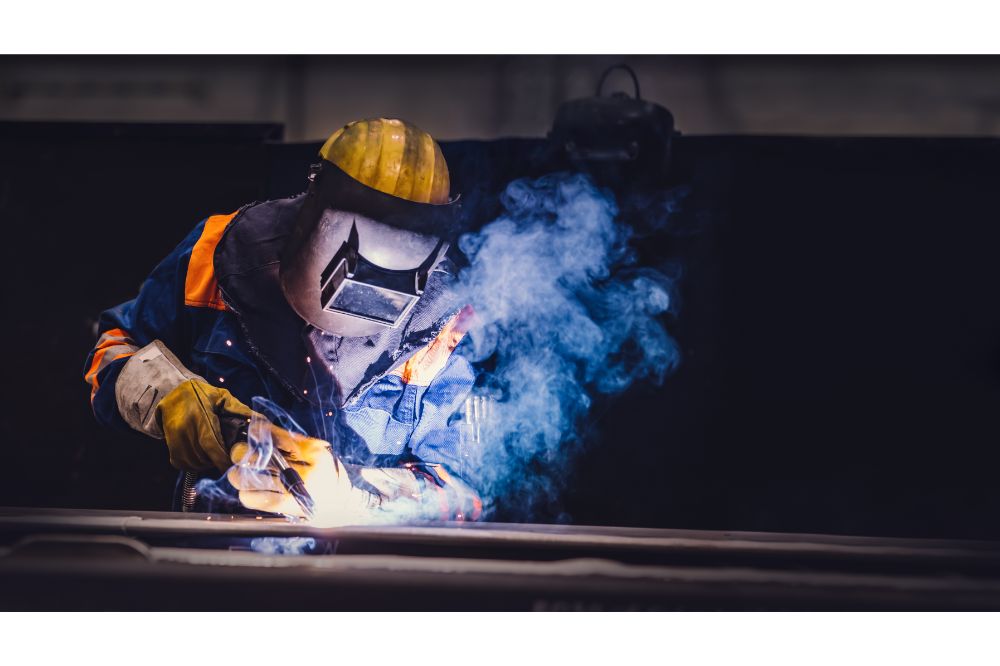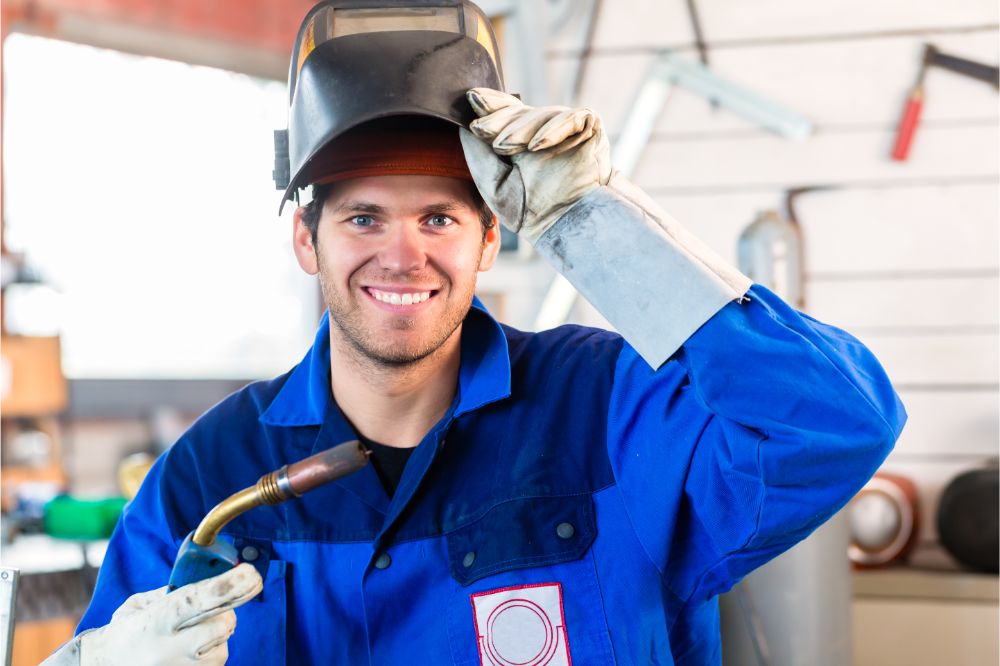A welding helmet is a personal protective gear built to protect your face, neck, and eyes from flash burns, harmful radiation, and bright lights from welding. There are two types of welding helmets: passive and auto-darkening helmets. The latter has automatic functions that give your eyes continuous protection and visibility.
Auto-darkening welding helmets have layers of auto-darkening filters that work together to offer complete protection to your eyes. This article will outline these parts and the function of each of them in protecting your eyes. Read through to understand how this particular helmet works.
Why Do You Need an Auto-darkening Helmet?
So, why do you need an auto-darkening helmet? Why not go for a cheaper, passive helmet? Unlike passive welding helmets, auto-darkening helmets are more convenient and save you the hassle of moving your helmet up and down every time you need to see.
Additionally, the constant visibility allows you to work faster due to fewer disruptions. Also, you can easily maneuver through tight spaces, as you do not need to flip your gear up and down. Lastly, it has filters to give your eyes constant protection from infrared and ultraviolet rays even when it is not activated. So, yes, you need an auto-darkening helmet for assured maximum protection.
Breakdown of the Auto-Darkening Welding Parts
Auto-darkening helmets contain many filter lenses that protect your eyes from harmful radiation. Below is the breakdown of its parts.
The Ultraviolet/Infrared Filter
This is the outermost auto-darkening filter after the clear lenses. It is designed to protect you against harmful infra-red and UV rays using an ultrathin glass layer.
This filter is made of a thin layer of glass and a thick metallic layer. The latter consists of five silver and six aluminum oxide layers and is designed to filter out infrared radiation and protect the inner LC-cell layer from heat. Heat reduces the efficacy of internal lenses; thus, this heat protective layer is essential. Furthermore, the glass layer helps to filter out UV radiation.
Polarization Panel
This panel is designed to protect your eyes from bright and visible harmful light. The polarization panel works by dimming the light from the welding arc. They are three in number, with each layer appearing after every filtering layer. Also, the filter placed after the IR/UV panel is positioned perpendicularly for maximum light darkening. When you hit the welding arc, this layer auto-darkens to shield your eyes from harmful visible light.
Liquid Crystal Panel
The LC-cell layer consists of two panels arranged between polarizing filters. This layer protects your eyes by refracting light and is responsible for auto-darkening the helmet. These cells only bend light when electrically activated. So, you always want to ensure that your helmet is charged and you always have a spare battery for continuous protection.
Photo Sensors
These sensors are designed to detect light and send a signal for auto-darkening. For example, when performing a welding job, these sensors will detect and determine the intensity of light produced before stimulating the LC-cell layer to refract light according to the preset shades.
Related read: Best PAPR Welding Helmet
How Do Auto-Darkening Helmets Work
So how do these parts work together to make a functional welding helmet? When you strike a welding arch, the photo sensors on the front of the helmet send a signal that activates the LC-cell layer causing it to darken to the pre-determined shade levels. After you finish welding, the lenses automatically revert to a clear state, allowing you to inspect your weld and prepare for the next welding job.
In the event of the auto-darkening lens failing, the polarizing lens is designed to dim visible light hitting your eyes. It directs the bright light onto the liquid crystal cells, which refracts the polarized light perpendicular causing it to darken. Polarizing panels are a built-in safety feature meant to offer continuous protection to your eyes even when the helmet is not activated.
As you set to put on your helmet, modify the settings to suit your individual needs and preferences. The helmet will automatically auto-darken based on your settings.
A functioning helmet should be able to shield you from bright arch flashes. You will know it is not working if you see a bright weld flash seconds after turning it on.

What Should You Look at When Selecting an Auto-darkening Helmet?
So how do you know which type of helmet is a perfect fit for you? Below are some of the features you should look at to help you select the most suitable helmet.
Area of the viewing pane
You want a helmet that gives you the wide coverage necessary to take a full viewing range for maximum productivity. In addition, full coverage lenses come with enhanced comfort and ease of welding. Technically, this would mean helmets with a larger viewing area as they come with excellent peripheral vision and ease of positioning.
Light Sensitivity
This determines the intensity of light and sends signals to the lenses to adjust the shades accordingly. So, you want to go for a helmet with photo sensors that are sensitive enough to detect the slightest amount of light to keep your eyes safe. But on the other hand, a sensor with poor light sensitivity is very dangerous and will cause sight problems.
Light Sensor Control
Auto-darkening lenses automatically adjust light intensity from the welding arch to make it comfortable for your eyes. However, you will sometimes need to change the light sensitivity manually to suit your eyes. This is because eyes react differently to light intensity; a brightness comfortable to your eyes is not the same for another person. Thus, you want a helmet that allows you to adjust light sensitivity to suit you.
Lens reaction time
Reaction time refers to how fast liquid cell lenses react to a flash from the welding process. Typically, a helmet with less reaction time offers better protection to your eyes; it acts faster to counteract the brightness before it hits your eyes. A good helmet should have a lens reaction time not exceeding one millisecond.
Power source
Manufacturers design auto-darkening helmets to use different power sources. Some use lithium batteries and others rechargeable batteries. You want to go for helmets that use Lithium batteries as these can be replaced. The problem with rechargeable batteries is that they degrade over time, and since you can’t replace them, you have to buy a new helmet completely. Also, some helmets use solar power as they come with solar panels that can be charged by the ultraviolet light from the welding arc.
Size and weight
Size and weight are very important features to look at as they determine how comfortable your helmet will be. Go for a helmet that your neck can support without causing any discomfort. Also, go for a size that perfectly fits without being too tight or wide.
Safety Standards.
Helmets that are compliant with safety standards in place are a safe option. These standards ensure that the helmets have been constructed to give you the required welding protection. In addition, these standards act as quality assurance, so you do not have to worry about the reliability of your auto-darkening helmet.
Conclusion
Auto-darkening helmets give you continuous protection and the visibility required to inspect your work after welding. They have a built-in safety feature to protect your eyes even when they are not powered. Additionally, the helmet stays clear and only darkens when sensing light, so you do not have to flip it up and down when you need to see.

